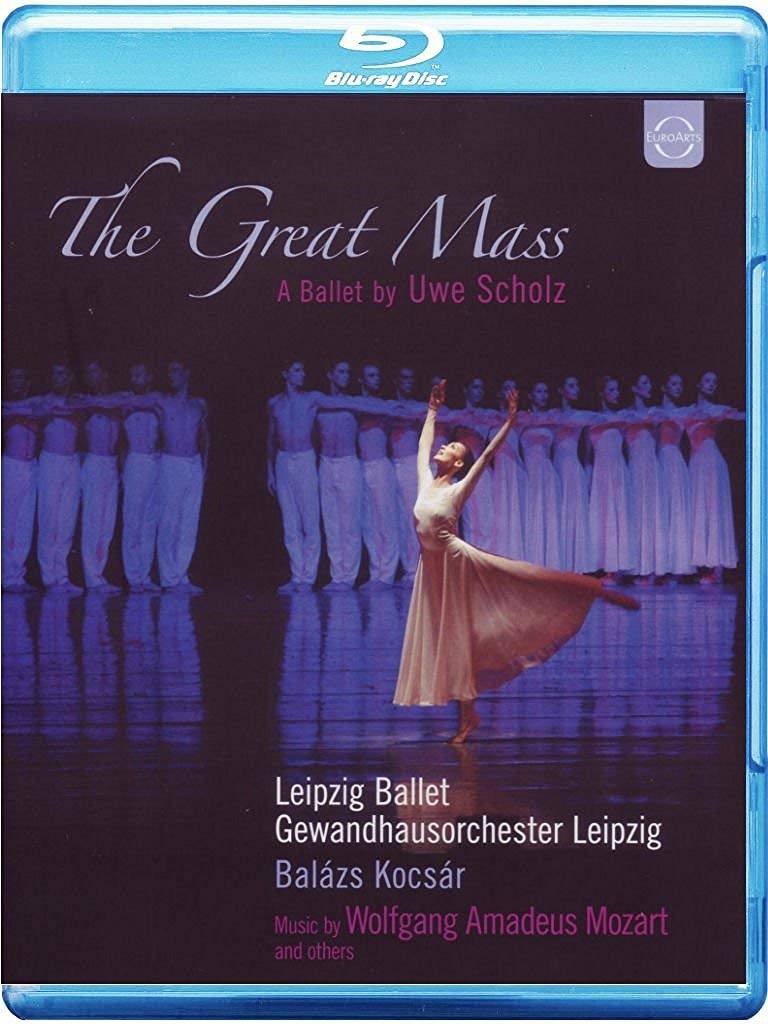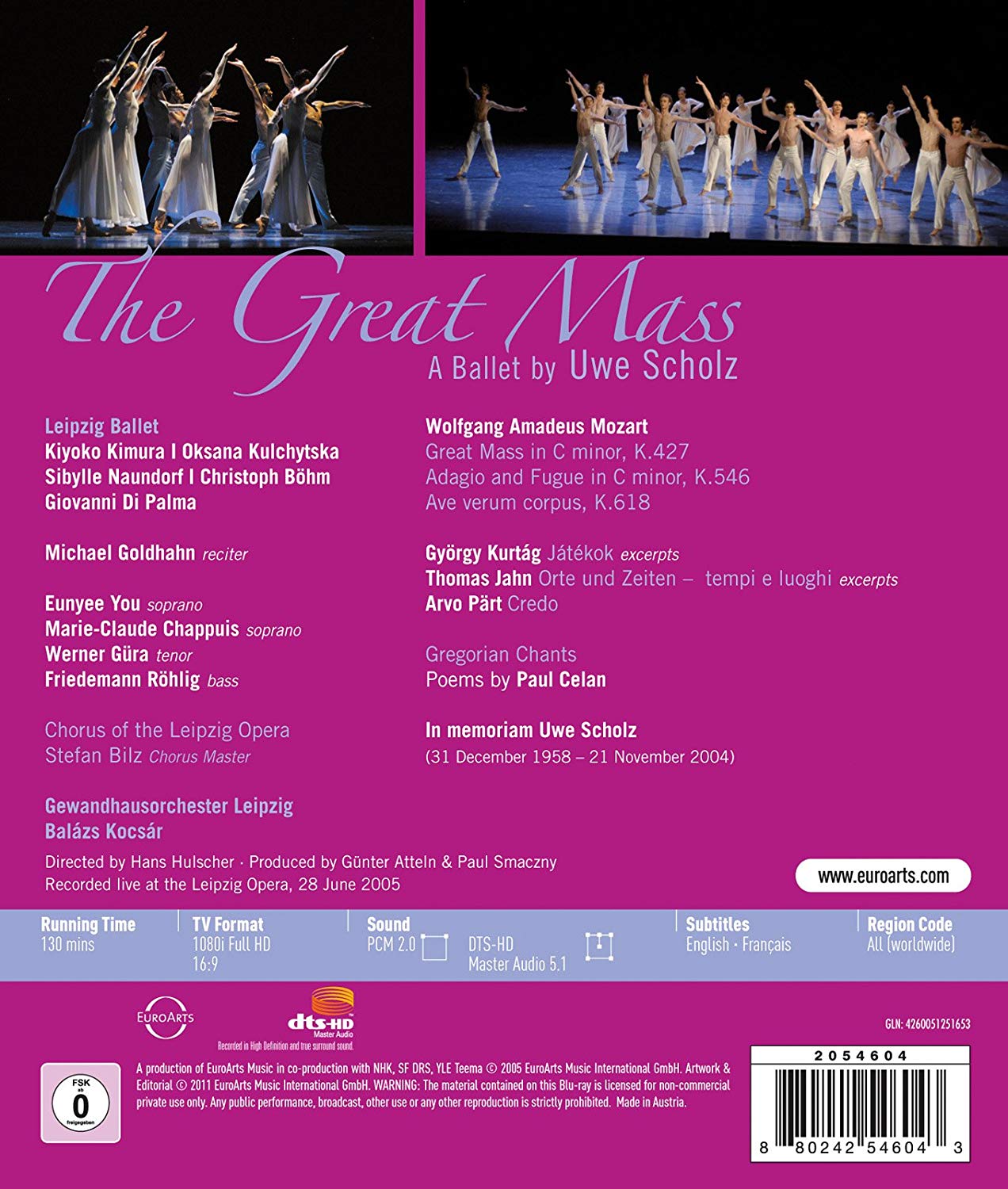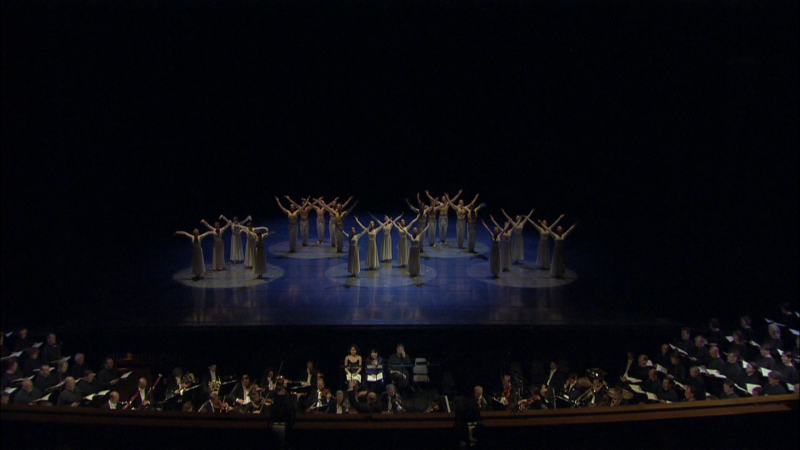

The Great Mass ballet. Uwe Scholz originally choreographed The Great Mass for the Leipzig Ballet in 1998. He died, age 46, on November 21, 2004. This production of The Great Mass was presented, in memoriam, on June 28, 2005 at the Leipzig Opera House. Music includes Gregorian chant as well as pieces by Mozart, Thomas Jahn, György Kurtág, and Arvo Pärt. Stars Leipzig Ballet first soloists Kiyoko Kimura, Oksana Kulchytska, Sibylle Naundorf, Christoph Böhm, and Gionvanni Di Palma; soloists Maiko Oishi, Elena Tumanova, Sebastian Angermaier, Rémy Fichet, Michael Goldhahn, and Yuichiro Yokozeki; demi-soloists Alla Bykanova, Irina Goloubeva, Anna Tsybina, Ekaterina Tumanova, Sven Köhler, Mirko Mahr, and Mohamed Youssry. There is also a spoken (whispered) part with poems by Paul Celan recited by Michael Goldhahn. Balázs Kocsár conducts the Gewandhausorchester Leipzig and Chorus of the Leipzig Opera (Chorus Master Stephan Bilz). Solo singers are Eunyee You, Marie-Claude Chappuis, Werner Güra, and Friedemann Röhlig. Drected for TV by Hans Hulscher; photography directed by Nyika Janscó; produced by Günter Atteln and Paul Smaczny. Released 2011, disc has 5.1 dts-HD Master Audio sound. Grade: C
Even though I find it quite disappointing, I have to be careful what I say about this production and its recording. A lot of people seemed to have liked it, and it is presented in memorium at a special event in honor of Uwe Scholz. So I have to keep an open mind.
Scholz attempted to create a new, great mass in dance form with 4 components: (1) traditional core liturgy [Ordinarium] (2) optional liturgical elements [Proprium], (3) prayers [Gebete], and spoken poetry [Lesungen]. See notes from Scholz's sketchbook printed in the keep-case booklet for a discussion of this.
All the core music is from Gregorian chant and Mozart's Great Mass in C minor K 427. Mozart worked on the K 427 Mass in 1782/3, but he never finished it. Still, it's probably the most famous piece of sacred music by Mozart. (This should not be confused with the incomplete Requiem Mass that Mozart was working on at his death in 1791.) The core music is coupled with "chaste," traditional choreography featuring women in long white dresses and bare-chested men in formal white pants. Here are some screen shots from Chapters 1-10 of dancing set to Mozart's Kyrie and Gloria:
I call this a "school of fish" formation, which is the basic style Scholz uses for his core dancing:
Along with the swirling schooling formations, Scholz uses geometric figures with precision unison movements. The corps doubtless spent huge amounts of time drilling to execute the geometrics correctly:
Meanwhile, the orchestra, chorus, and singing soloists are performing well. Here's a double-exposure shot of soprano Eunyee You and a dance formation. You is almost as beautiful to watch as to hear. The camera keeps going back to her. At some point the editor had to say, "We're doing too much of You. She's starting to steal the show."
I was a little surprised to see shots like this during Mozart's Gloria:
Now we have some patterns that are geometric and full of movement as the dancers march across the stage on intersecting diagonals. This is probably the most impressive dance segment in the entire production:
We enter Chapter 11 (of 33 Chapters total). From here on Scholz uses other material (optional liturgical elements, prayers, and spoken poetry) mixed in with the remaining portions of the Great Mass that Mozart finished. The dancers wear white for the Mozart and black for most of the other material. We see black costumes first in a series of short movements involving small numbers of dancers in front of mirrors. The Leipzig Opera has a huge stage. The small groups of dancers clad in black and dancing with minimal light must have been hard for the audience to see. Here one of the men shocks his partner by grabbing his privates:
Here's a really dumb stunt (but not the dumbest). Start off with a (silent) scream and then follow up with an illusion:
The small scale acts are followed by the introduction of a solo character (Michael Goldhahn) who hovers about for many chapters reciting obscure poetry by Paul Celan and acting as Master of Mysterious Ceremonies. I assume this new character represents Scholz. Here he recites verses (there are subtitles in English):
The mystery acts include a number of seemingly unrelated dance segments such as this scene in blue (note the reciter is sitting on the stage observing):
The mystery acts continue until we are back in Mozart's core with his Credo:
But there's plenty of other wild stuff to come:
Here's the dumbest stunt of all: a game of musical chairs:
Now we reach Mozart's Sanctus with dancers in white again (the reciter is still sitting on the stage):
And back to the school of fish:
But there's a new surprise before we get to Mozart's Agnus Dei. To strange music from Thomas Jahn, the stage hands roll up the floor and the dancers come out still sweating and sit around in street clothes:
This sitting on the stage is part of the performance. (There will traditional curtain calls later.). The dancers listen the same as the audience to the end of the Mozart music. One of them is maybe thinking, "This is the greatest day of my life." Another is maybe thinking, "My father warned me not to waste my life as a dancer, and he was right."
So what to make of all this? The music is well-performed and recorded. You could almost make a case for turning off the TV and just listening. This production was done on a mostly dark stage, and the director did not allow enough light for the cameramen to make a top-notch video with the equipment available. So the whole recording has a soft and slightly dingy look. Picture content is good with a good variety of long-range and closer angles. There are surprisingly few motion artifacts.
But I have reservations about the libretto and choreography. Because Mozart's Great Mass is incomplete, Scholz saw an opportunity to add other stuff to "complete" or improve on Mozart's work. We have to admire Scholz's fearlessness. But if you are going to improve on Mozart, what you do had better be good. Remember what happened to that angel who tried to create something greater than God?
Scholz got off to a good start in Chapters 1 through 10. But then he wanders off (beginning at track 11) into some of the most jarring, banal, obscure, and even silly material one could image putting on the stage of a famous mainstream German opera house.
If you are a dance insider or do enough homework, perhaps you can sort through this and make sense of it. Scholz believes mankind is worse than ever; the Mass has to be better than ever, or at least, universal, etc.
But I don't buy it. The first few times I tried to watch this, I quit in the middle out of exasperation or boredom. Gritting my teeth, I made it through later several times, and I just watched it yet again for this review update. The Scholz white acts could have made for a decent shorter ballet. But the expanded work suffers from intellectual pretentiousness aimed at rehabilitating mediocre choreography. The project founders on too much bad choreography and a lack of emotional consistency.artefacts
I wind up with a C grade, which is pretty bad for a ballet. Perhaps I'm wrong about this. If you can write a comment or review that supports a better grade for The Great Mass, I would be delighted to publish it!
OR





















